Review: Patek Philippe Pilot Annual Calendar Travel Time
by Tim Mosso
Patek Philippe has no meaningful history of pilot’s watches, so the 2015 advent of the Calatrava Pilot collection was both an exercise in grasping at straws and a flight of fancy.
Despite pundits’ cynical comparisons to Zenith, IWC, and Laco at the time, Patek’s pretend pilots have proved their relative practicality and staying power.
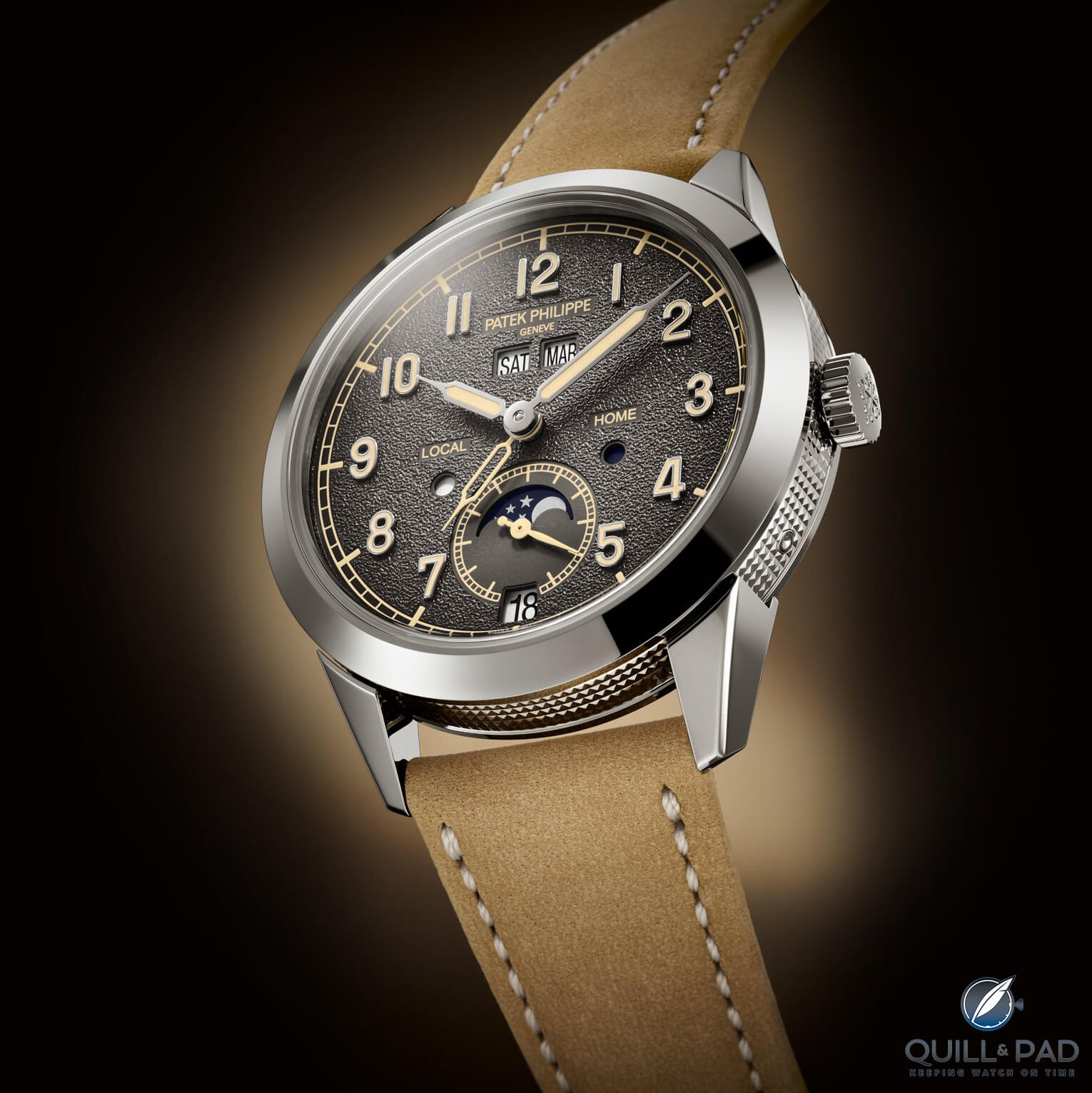
Patek Philippe Pilot Annual Calendar Travel Time Ref. 5326G-001
The Pilot Annual Calendar Travel Time 5326G breaks new ground in design while offering enough features to justify itself – real aviation heritage or not.
The common threads of the now numerous Pilot variants are round cases, potent lume, high legibility day or night, and a strap-buckle tandem evocative of early 20th-century flight gear.
To that list, the 5326G adds an annual calendar and a travel time function. The former is a modern Patek Philippe brand mainstay while the latter was inherited from the original 5524G of 2015.
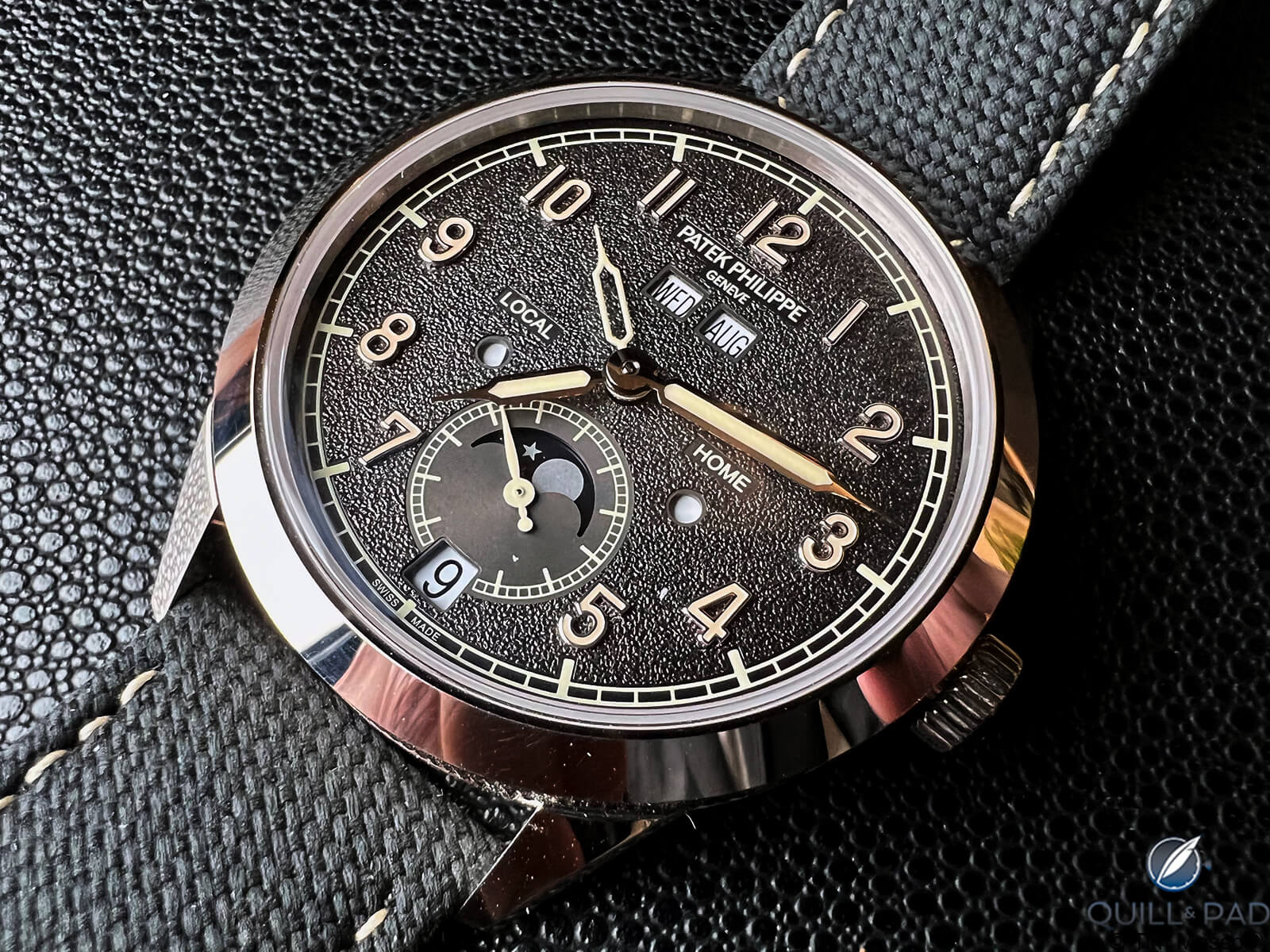
Patek Philippe Pilot Annual Calendar Travel Time Ref. 5326G-001
However, the 5524 employed large crowns on the left side of the case to jump the local hour hand clockwise or counterclockwise. The resulting aesthetic drew comparisons to a tuber with eyes, warts on a hog, or contact triggers on a naval mine.
In other words, the look was as controversial as the 5524 itself. For the 5326, Patek retired the external pushers in favor of a new setting system accessible solely from the crown. Users can alter the local hour as needed while leaping between time zones.
As with the previous Patek travel time models, the local hour hand and the skeletonized travel time hand move in identical 12-hour circuits. This allows them to be superimposed for a cleaner dial when the second time zone is not required.
Patek’s industry-non-standard practice on recent travel time models has been the inclusion of am/pm indicators for both local and reference time zones.
————————————————————————————
————————————————————————————
While an indication of day/night for the user’s current locality is borderline silly, it does provide symmetry and balance to the dial. And travelers on long-haul flights might benefit from seeing the day/night split between origin and destination, so double day indicators might not be solely aesthetic.
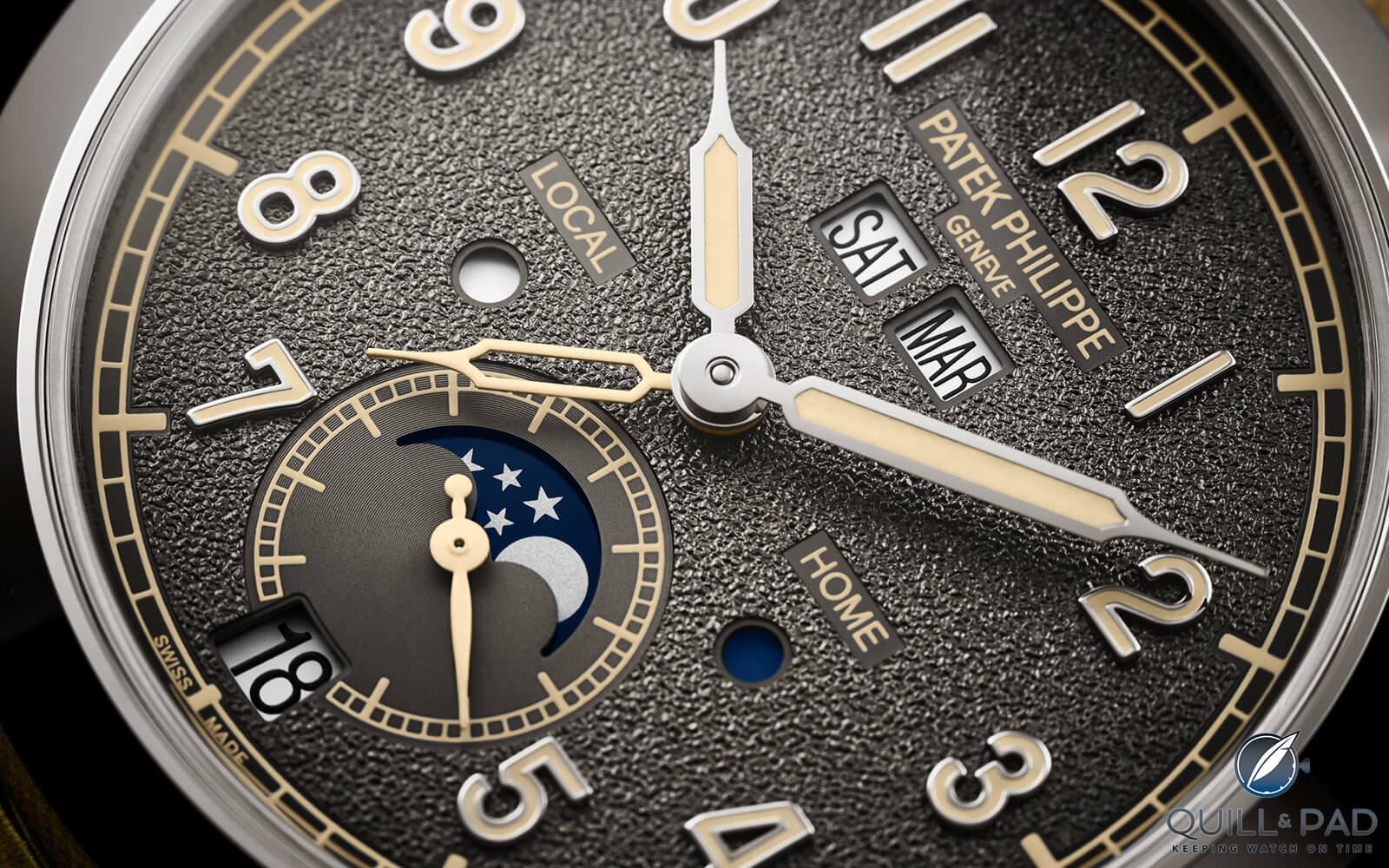
Patek Philippe Pilot Annual Calendar Travel Time Ref. 5326G-001
Patek Philippe invented the annual calendar in 1996 and brought it to market on the landmark 5035. While a perpetual calendar can negotiate irregular length months and almost all four-year cycles, the tandem “grand lever” and program wheel traditionally employed by Patek was expensive, delicate, and inefficient in its use of space.
In contrast, a simple triple-calendar can be constructed economically and assembled by technicians with less experience, but it requires five corrections per year.
Patek watchmakers devised the annual calendar to provide an element of sophistication on models priced below the level of a true perpetual calendar.
The mechanism requires only a single correction per year – annually – during the transition from February to March. Better still, the annual calendar’s function can be achieved using only wheels in combination.
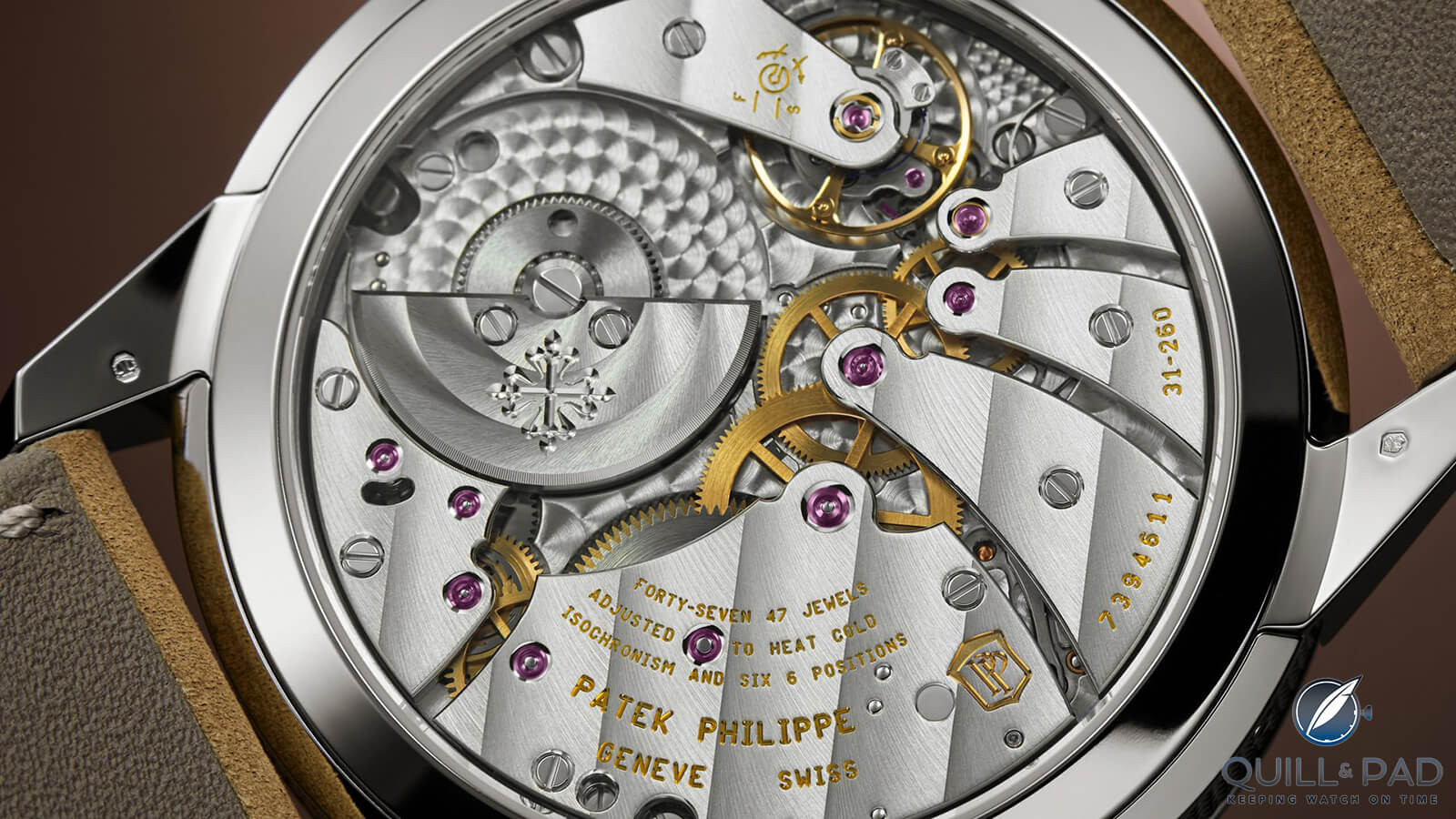
Patek Philippe Caliber 31-260 PS QA LU FUS powers the Pilot Annual Calendar Travel Time Ref. 5326G-001
This improves the packaging of the movement, the economy of assembly, and it permits less veteran or less qualified watchmakers to adequately service the movement.
Because moonphase displays are wheel-driven regardless of calendar style, Patek elected to give the 5326G a perpetual-style 122-year moonphase (135 tooth wheel) instead of the “two-year-plus” moon (59 teeth) often featured with basic calendars.
————————————————————————————
————————————————————————————
Patek Philippe builds annual calendars with either aperture or sub-dial displays, and the legibility-driven 5326G gets the aperture variety. Day, date, and month are easy to view within their display windows, and the user is spared the annoyance of scrutinizing tiny radial scales and even smaller hands.
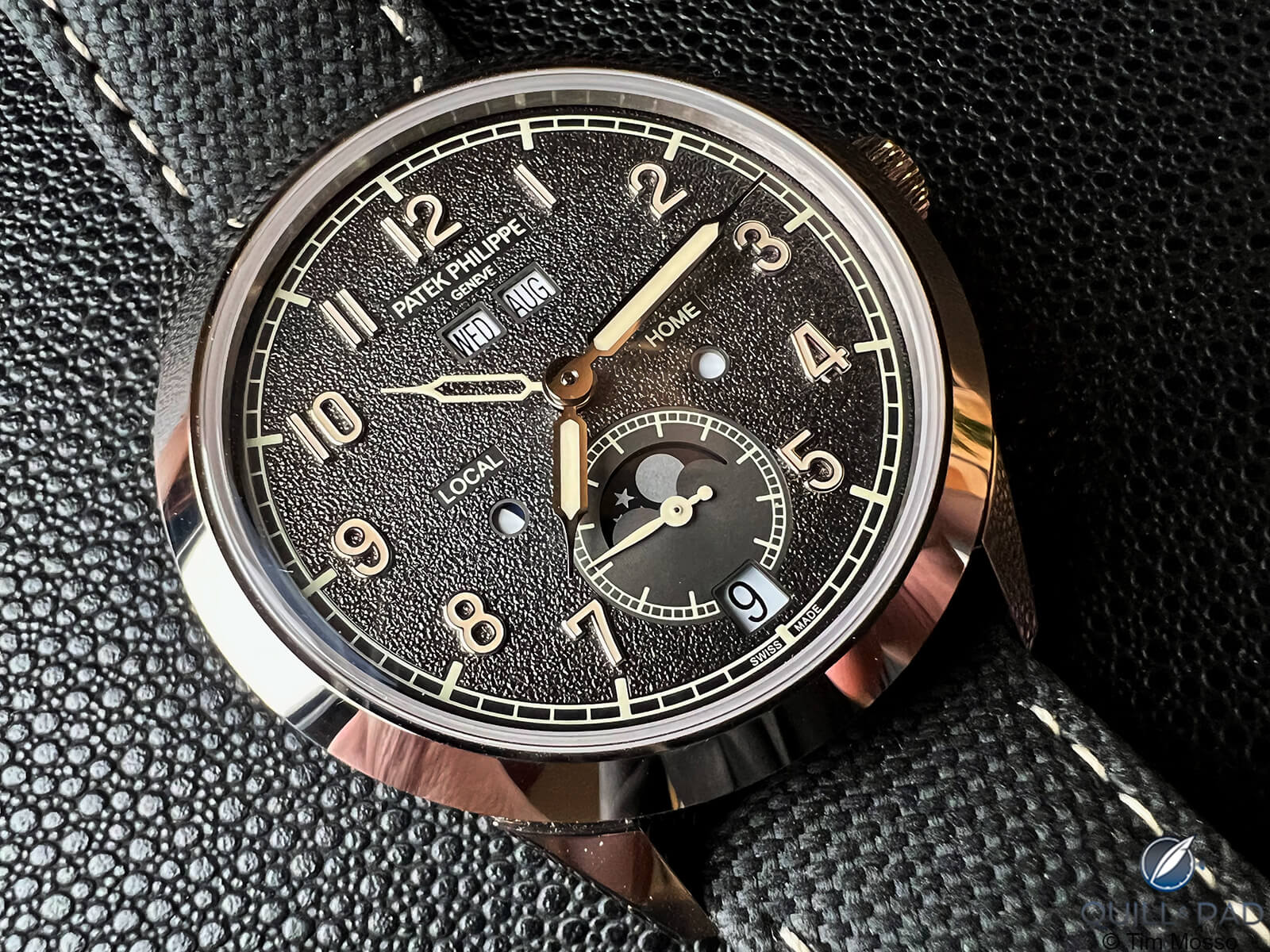
Patek Philippe Pilot Annual Calendar Travel Time Ref. 5326G-001
Moreover, the use of a vertical column of calendar displays endows the dial with perfect bilateral symmetry.
The Pilot Annual Calendar Travel Time is a large watch at 41mm in white gold. Its mass is tangible in the hand and on the wrist. It feels substantial and expensive. But size pays dividends on the dial where none of the many features appear crowded or haphazardly arranged.
The large face enables sizable Arabic numerals laden with lume. This delivers easy reading by day and sports watch-level visibility by night.

Patek Philippe Pilot Annual Calendar Travel Time Ref. 5326G-001
Although a true vintage pilot’s watch would have featured printed or transferred markings, white gold applied Arabic numerals impart the requisite brand majesty; this is a Patek Philippe, after all.
Syringe hands provide a delicate and graceful complement to the numerals, but the pervasive use of ecru-colored “fauxtina” across the dial stands as the most controversial element of the entire watch.
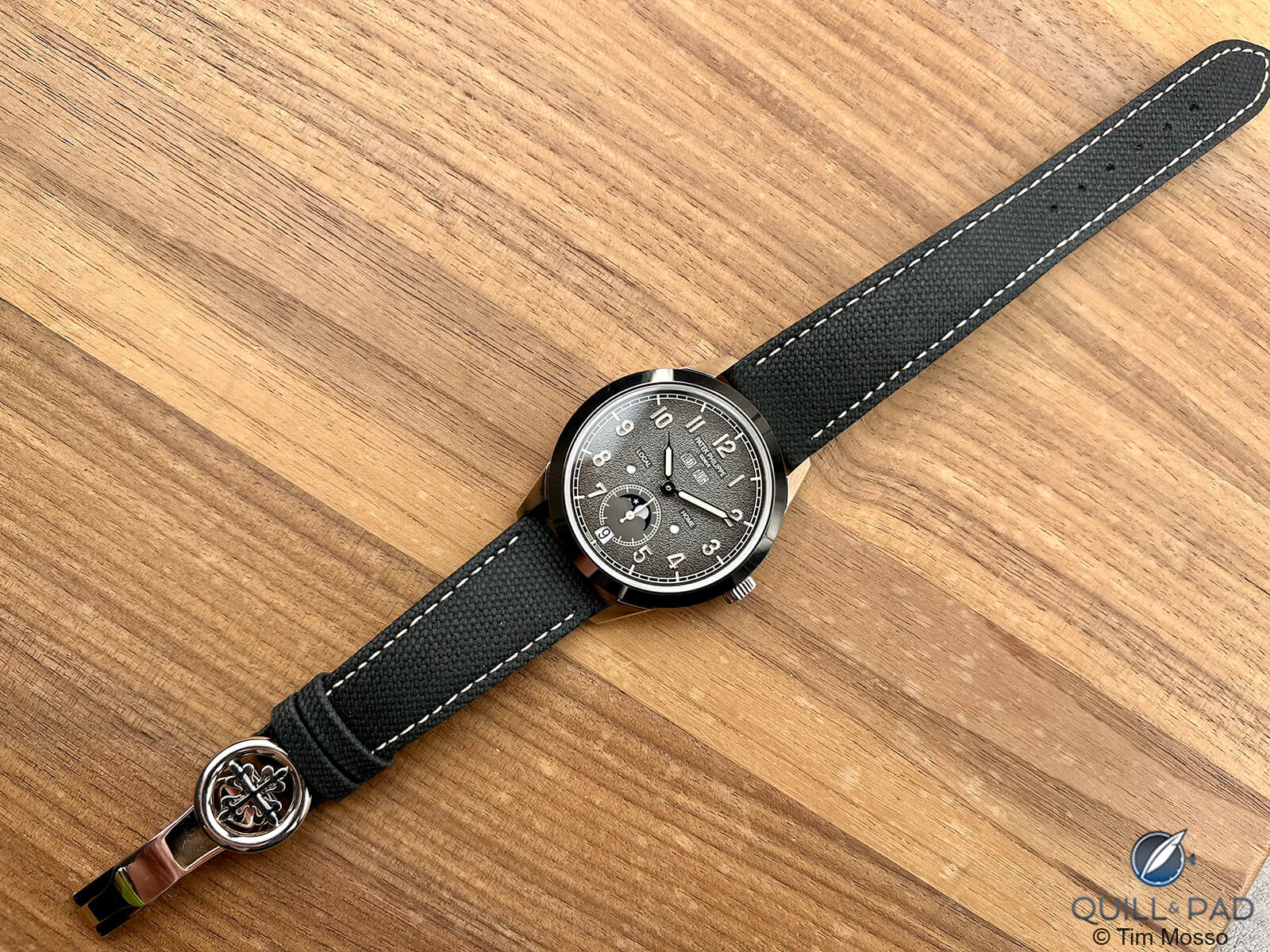
Patek Philippe Pilot Annual Calendar Travel Time Ref. 5326G-001
As a contrived device to suggest aging that never was, this sea of beige reads as a hard miss. But if viewed strictly as a complementary color to the case, factory straps, and textured charcoal dial, the ecru spread adds warmth to this otherwise chilly white gold and grey timepiece.
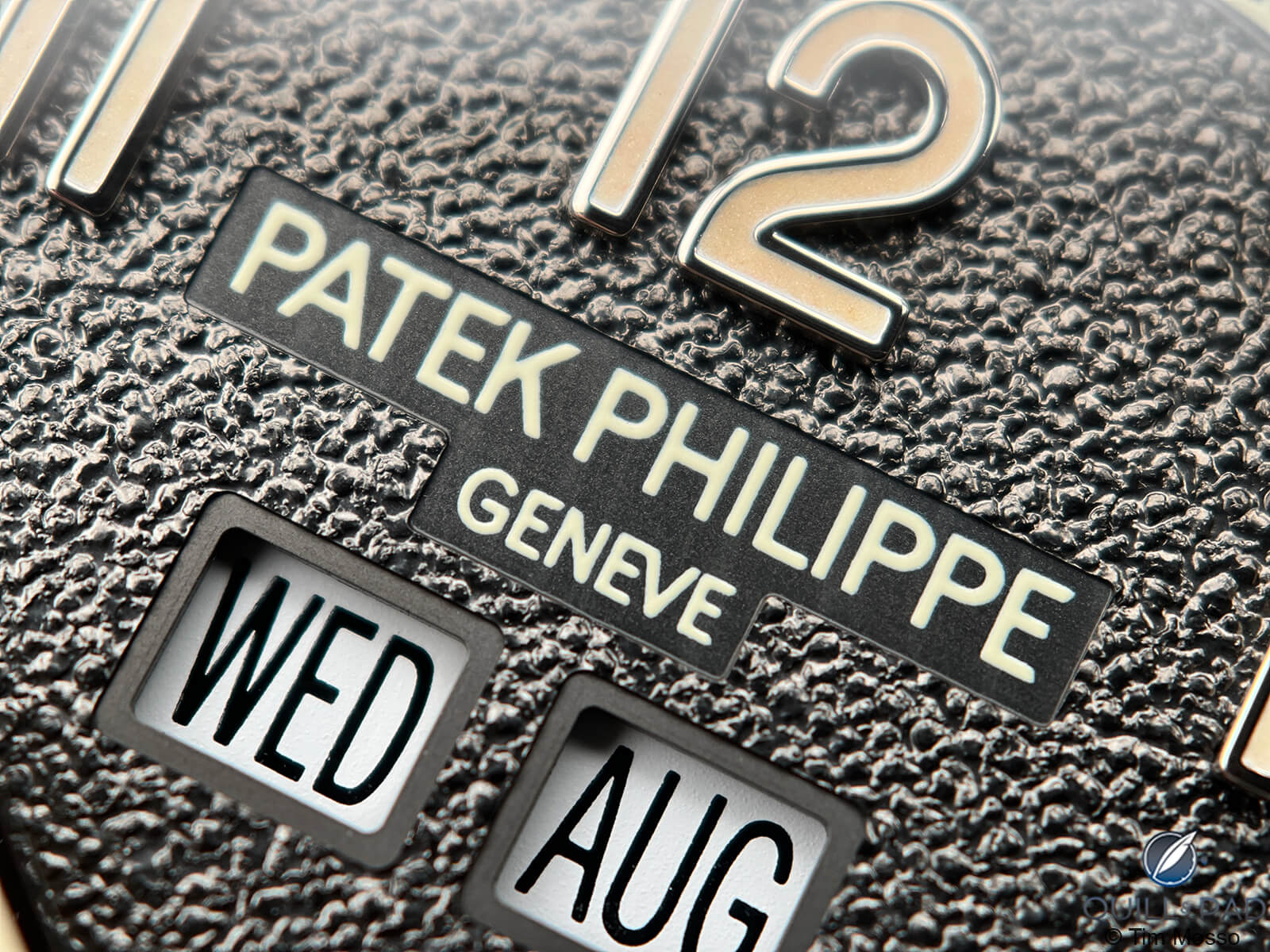
Dial closeup of the Patek Philippe Pilot Annual Calendar Travel Time Ref. 5326G-001
About that grey: Patek Philippe wants you to know that it’s officially “textured charcoal.” Subtly grained sandpaper-like dials have been a feature of the Patek “Pilots” since inception, but the 5326G deploys a texture so coarse as to resemble weathered asphalt with a glaze of lacquer.
It’s a new look for Patek Philippe and a leap of faith for Thierry Stern on par with the stainless-steel face of the original 5235G and the cycloptic gaze of the 5236P’s inline calendar.
————————————————————————————
————————————————————————————
Moreover, the 5326G’s rugged visage exemplifies of Patek’s recent dive into the voguish world of fumé or gradient fade dials. Its center is notably lighter than the outer reaches below the railroad track minute scale.
In aggregate, this machine’s design departure is successful on its own terms, but the effect might earn a love/hate reputation with time.
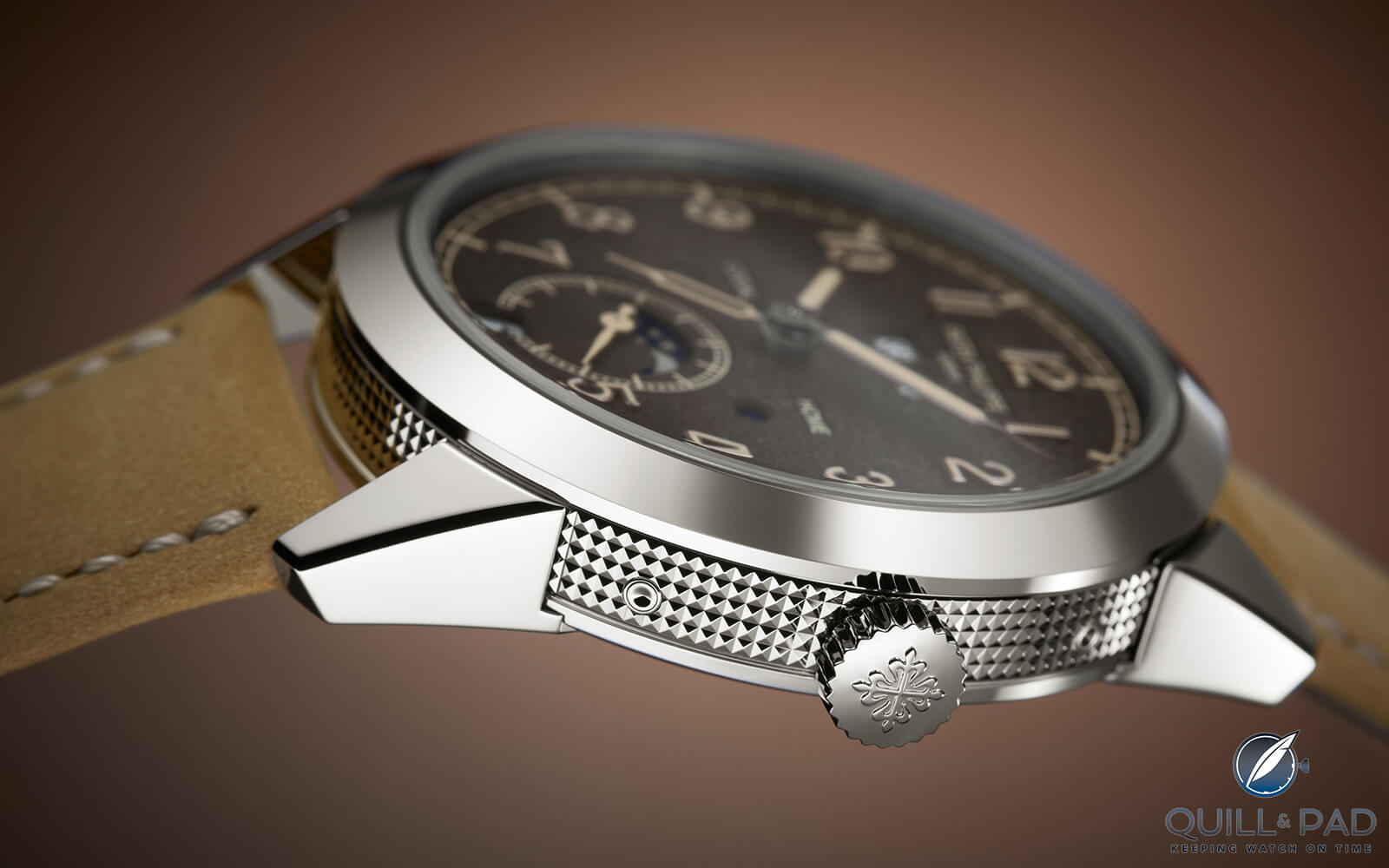
Patek Philippe Pilot Annual Calendar Travel Time Ref. 5326G-001
Externally, the 5326G represents a serious departure from conventional round-case Patek models. The pyramid-style hobnail texture of the caseband is as audacious as the “texture” of the dial. It breaks up the sheer of the cylindrical case and provides a sharp contrast with the polished lugs.
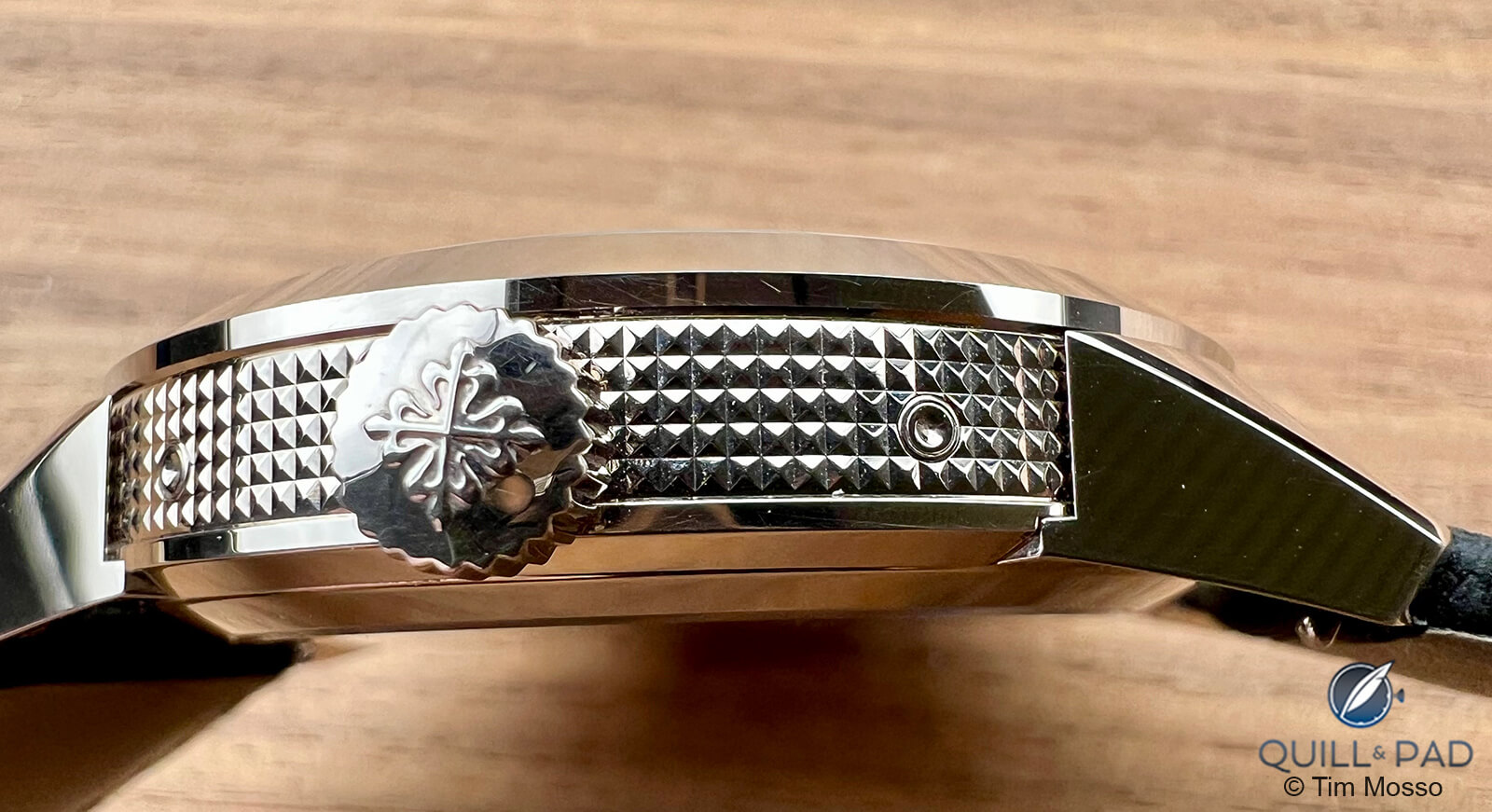
Patek Philippe Pilot Annual Calendar Travel Time Ref. 5326G-001
Those angular lugs, which attach to the caseback but not the center case, appear to float free of the central vessel; you can stick a piece of paper between each lug and its adjacent case flank.
Few Patek models below the level of hand-engraved flagships feature quite as much exterior sculpting or as many case quirks as the 5326G.
Mechanically, the Pilot Annual Calendar Travel Time continues Patek Philippe’s advance beyond its aging caliber 324 and 240 automatic movement families.
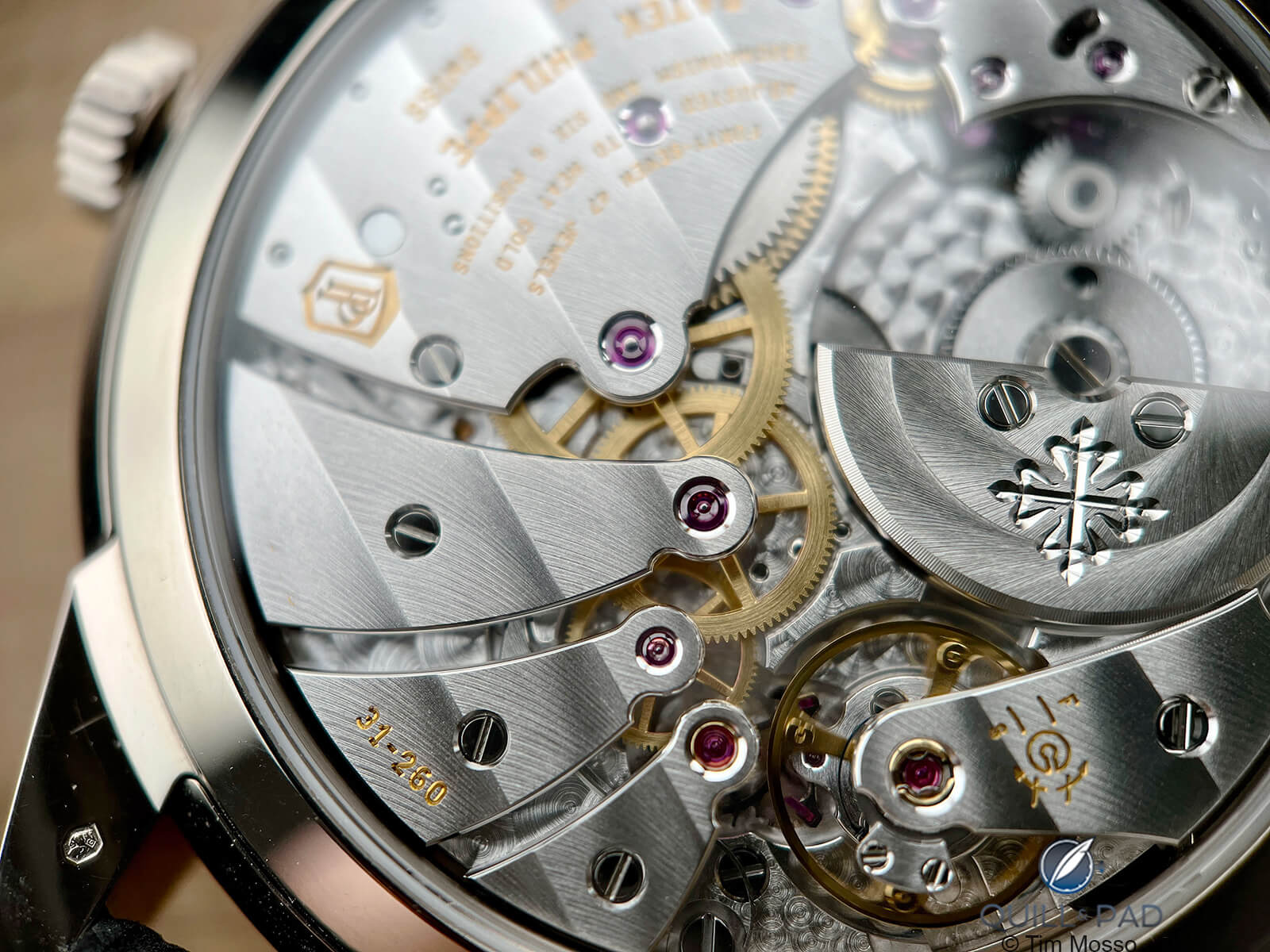
Patek Philippe Caliber 31-260 PS QA LU FUS powers the Pilot Annual Calendar Travel Time Ref. 5326G-001
The micro-rotor 31-260 in the 5326G looks the part with a diameter of 33mm compared to the 240’s petit 27.5mm. This big bore auto debuted in the 5235G back in 2011, but its expansion beyond that reference took a full decade.
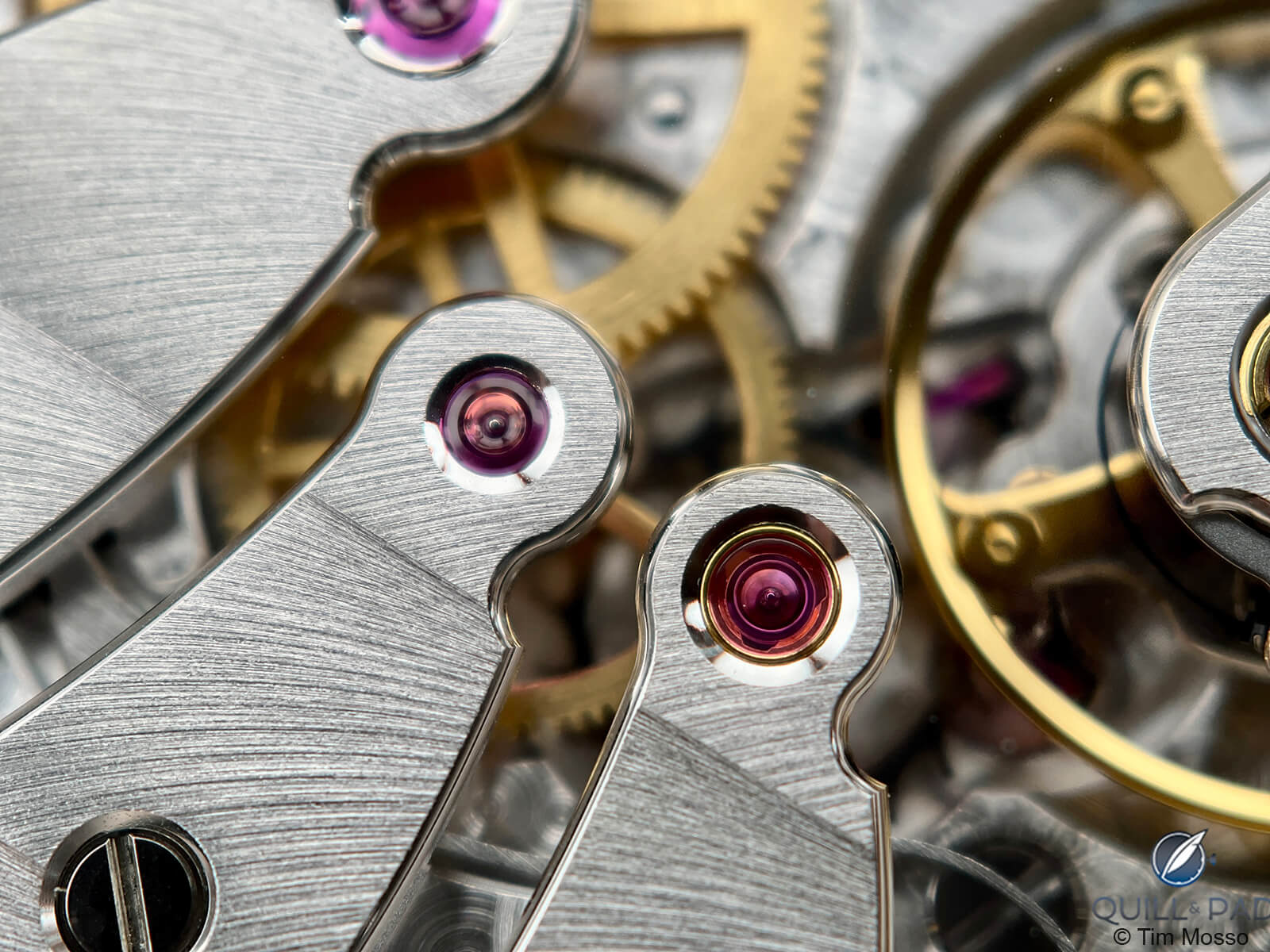
Patek Philippe Caliber 31-260 PS QA LU FUS finger bridges
It was worth the wait. The architecture of the 31-260 reveals careful attention paid to the use of vintage-inspired finger bridges that follow a crescent-shaped arc from the mainspring barrel to the balance.
————————————————————————————
————————————————————————————
Finish quality is laudable. Patek Philippe notably does a better job than its “trinity” counterpart Audemars Piguet of disguising the elements of mechanical fabrication that are inevitable in any watch built in more than a few dozen copies per year.

Patek Philippe Caliber 31-260 PS QA LU FUS circular graining
The 31-260’s bevels, stripes, engine turning, and polishing of parts all appear convincingly artisanal even though it’s matter of common knowledge that several machines and at most one set of hands fashion each component of this mass-produced caliber.
For example, the timid rounding of the bridge angles around the pivots betrays the series-production nature of this movement.

Patek Philippe Caliber 31-260 PS QA LU FUS movement finishing
On the other hand, Patek’s style department specified extraordinarily broad côtes de Genève, which look fantastic.
To maximize rotating mass and winding efficiency, the micro-rotor is machined from a block of platinum and rolls on hybrid ceramic bearings. Hacking seconds, long a sore subject for Patek Philippe devotees, mercifully is present.
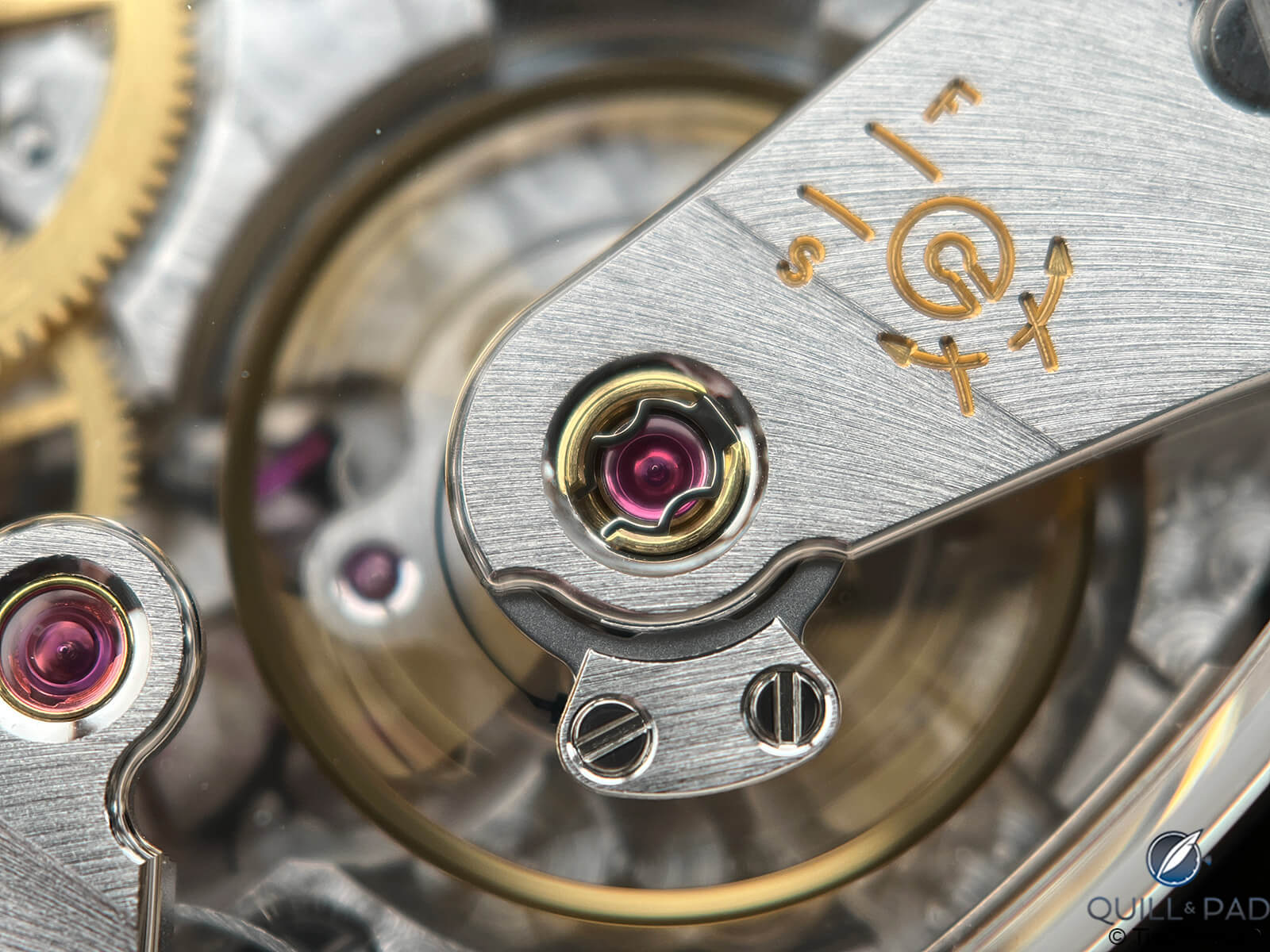
Gyromax free-sprung balance of the Patek Philippe Caliber 31-260 PS QA LU FUS
The aggregate of refinements such as the Gyromax free-sprung balance, Spiromax silicon hairspring, six-position adjustment, and Patek Philippe seal underpins the factory’s attestation that the watch should run no worse than -3/+2 seconds per day when freshly assembled or recently serviced. The bias towards time loss is odd, but the result still surpasses the COSC’s -4/+6.
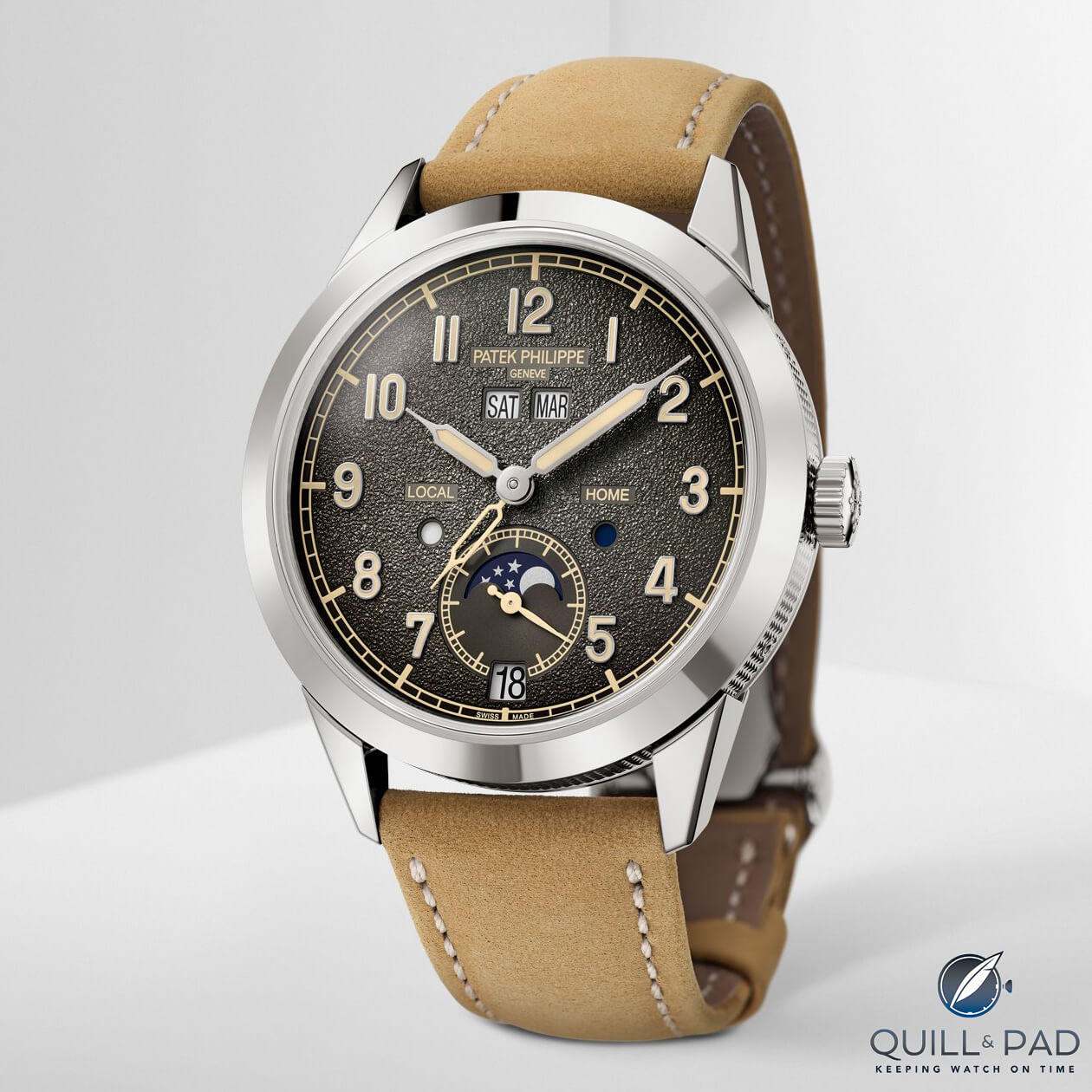
Patek Philippe Pilot Annual Calendar Travel Time Ref. 5326G-001
At nearly $80,000, the Pilot Annual Calendar Travel Time costs as much as a graduate degree and far more than virtually all simple Calatravas.
But no luxury watch purchase makes any big-picture sense, and the face-melting prices being paid for steel Patek sports watches casts a feature-laden everyday companion like the 5326G in a favorable light.
For those times when a person needs to 1) swim or 2) flip a watch for the price of a Porsche 911, there’s the Nautilus. For all other occasions, it would be a pleasure to consult the Pilot Annual Calendar Travel Time.
For more information, please visit www.patek.com/en/company/news/annual-calendar-travel-time-ref-5326g-001
Quick Facts: Patek Philippe Pilot Annual Calendar Travel Time 5326G-001
Case: white gold, 41mm x 11.2 x 48.9
Dial: textured charcoal gradient with luminescent paint and applied Arabic numerals
Movement: 31-260 PS QA LU FUS, micro-rotor automatic, 48-hour power reserve, hacking seconds, 4Hz, free sprung, adjusted in six positions, silicon hairspring
Functions: annual calendar, moonphase, second time zone, am/pm for local and home time
Price 2023: approx. $78,660
* Tim Mosso is the Media Director and Watch Specialist at Watchbox.
You might also enjoy:
Complete Guide To Type 20 Pilot’s Watch Chronographs
Patek Phillipe Calatrava Ref. 6007A: A Very Un-Calatrava Calatrava
Patek Philippe Reference 5101: Magnum Opus With Concealed Ten-Day Tourbillon
Why I Bought It: Patek Philippe Reference 5740/1G-001 Nautilus Perpetual Calendar
Leave a Reply
Want to join the discussion?Feel free to contribute!

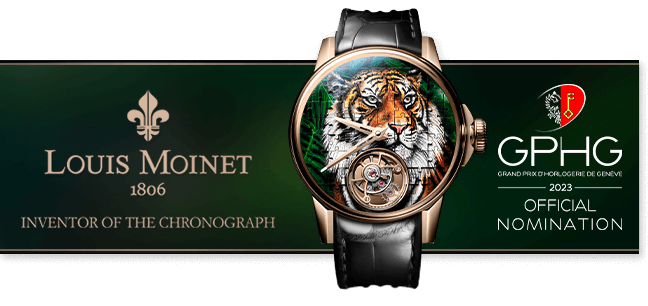
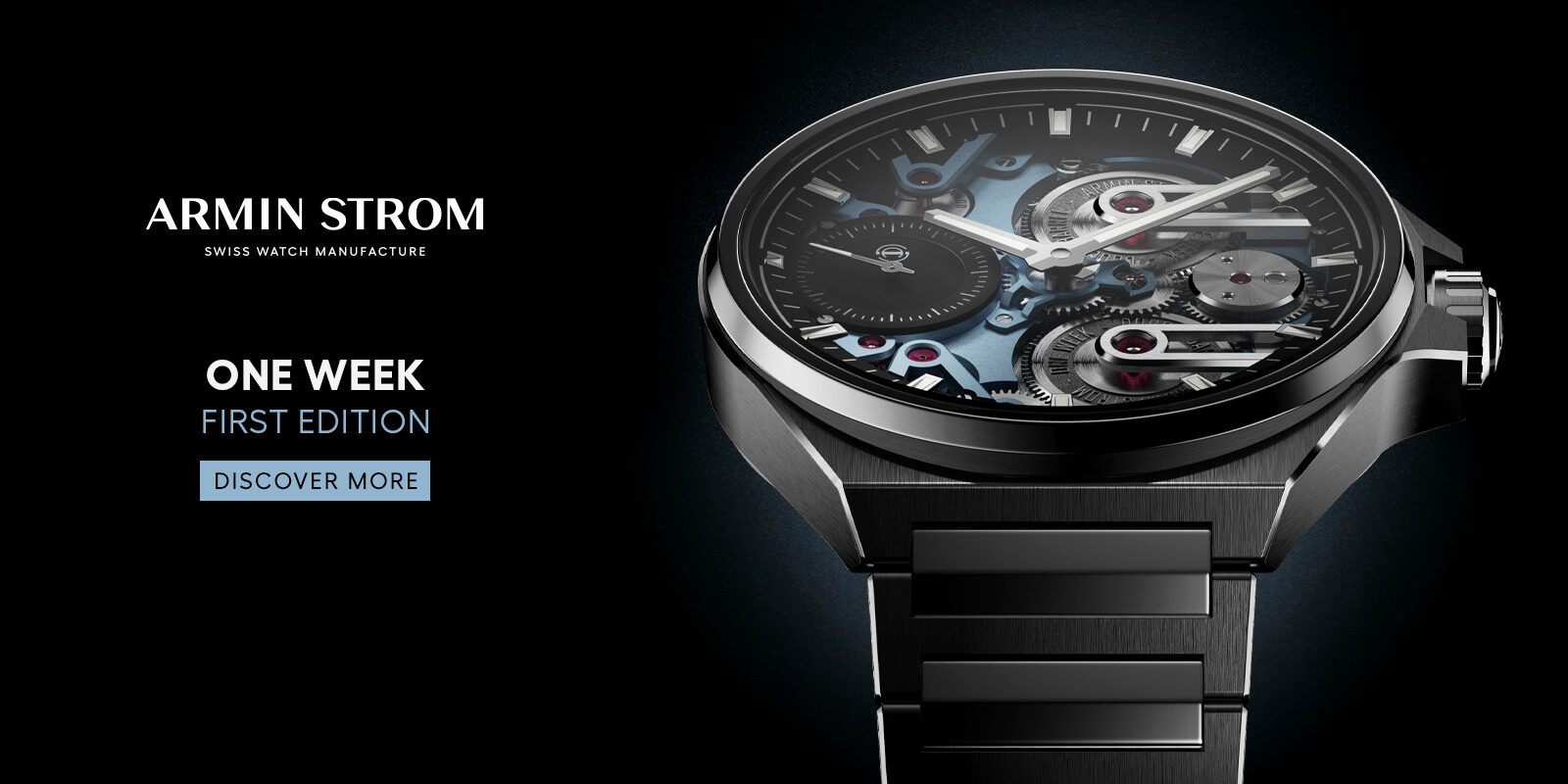
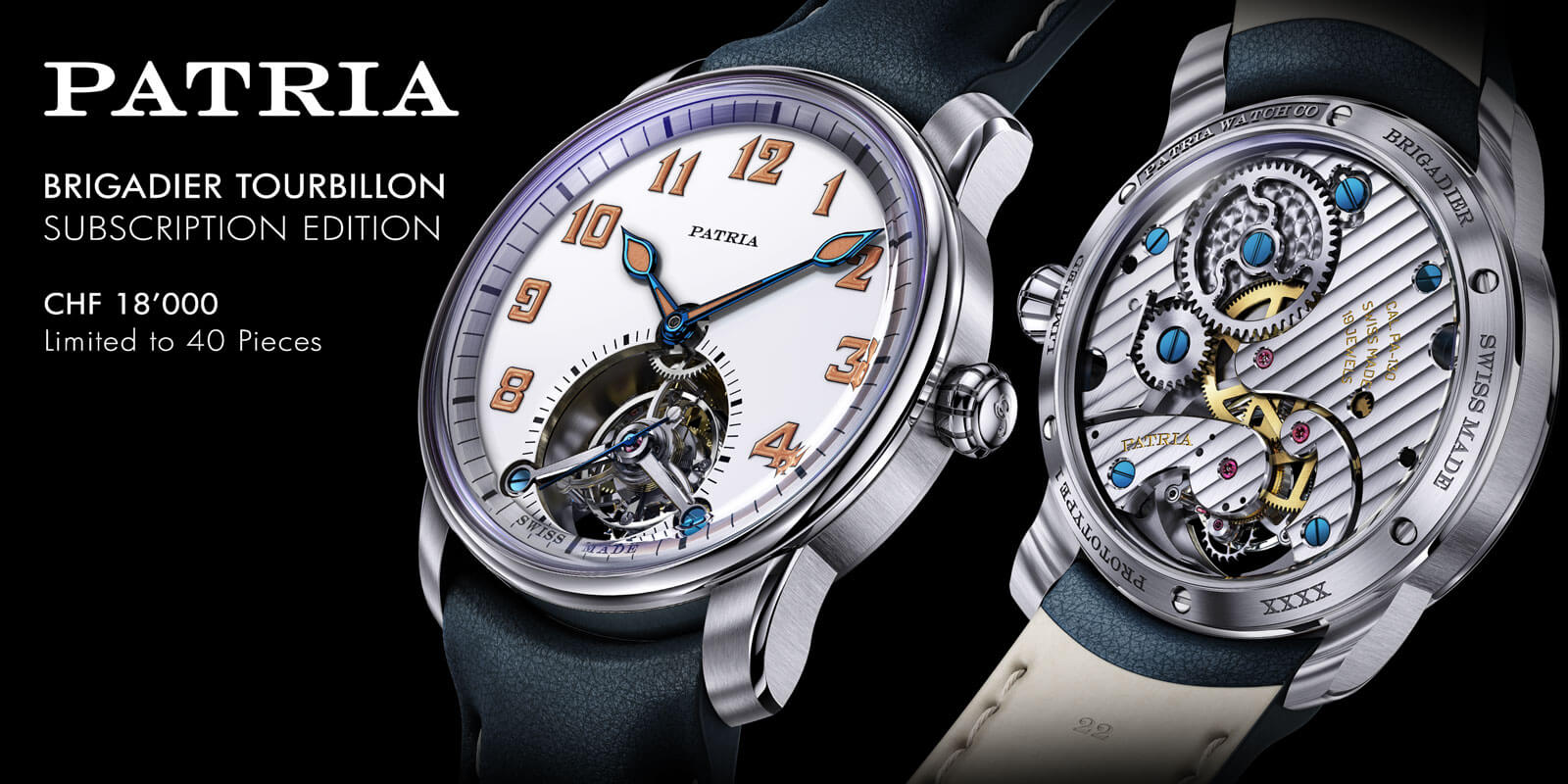
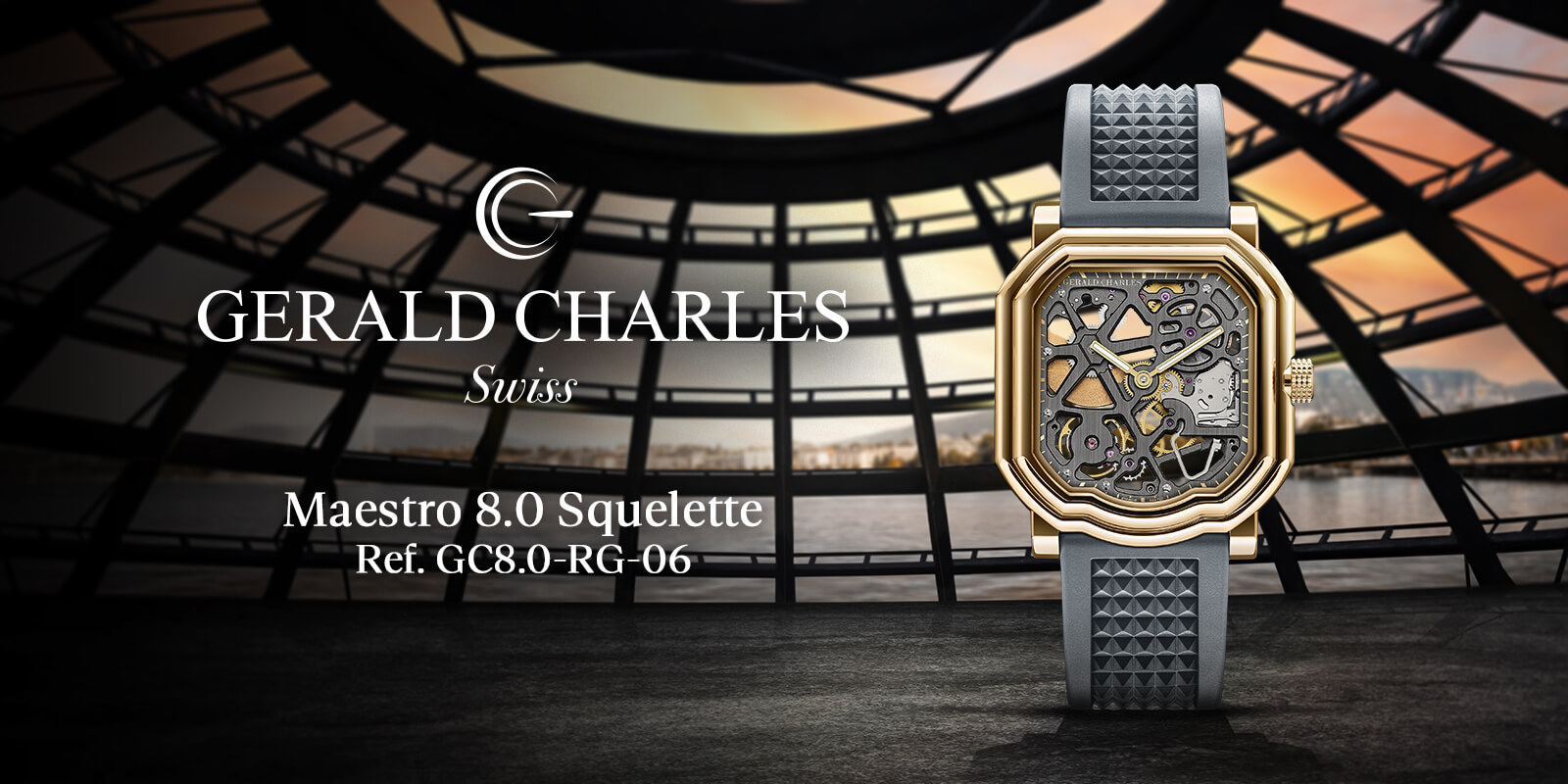


Very good review with keen observations of esthetics that could go either way with collectors.
Two issues for me.
1. In recent years I have set a rather low bar for a power reserve of at least 60 yours. Come on Patek. If pedestrian brands can do it, you can too! I’m sure it’s a tug or war with accuracy, but you gotta up your game.
2. I need to see this watch in the flesh. It photos well, as it has many interesting design elements (dial texture, hobnail finishing..). I’m just not sure of the total package when in hand.
We’ve all seen great watch picture that didn’t hold up when we finally saw a ref in the flesh. I recently had this very experience with PP 5235P. Photos look great, but I was disappointed when I saw the in-line triple calendar at an AD. IMO there is way too much open real estate on dial with a small trip,e calendar display.
Hopefully the current watch will view better.